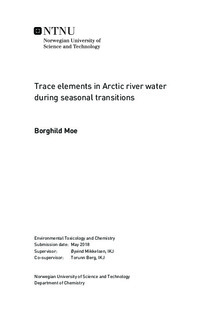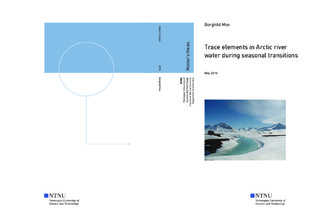| dc.description.abstract | Dissolved concentrations of trace elements in water samples from the Bayelva river in Spitsbergen have been determined. Samples have been collected in the very beginning and very end of the runoff season, otherwise denoted as spring and autumn. It has previously been indicated that levels of mercury, lead, copper, cadmium, chromium, zinc and nickel are higher during snow melt than after. The hypothesis that arose on the basis of these data was that atmospherically deposited elements accumulate in the snowpack throughout winter.
The aim of this study was to further investigate this indication by comparing spring and autumn levels of trace elements. In this case the very early spring and very late autumn. These transitional periods i.e when runoff is just starting, and ending emerged as an interesting and not extensively researched time in the runoff season of Bayelva. Levels of trace elements found in this study have been compared to data from previous years (2009-2016), to see if differences between spring and autumn can be seen over time. Parameters such as pH, conductivity, redox potential and turbidity have also been measured, and samples for analysis of dissolved organic matter have been collected.
Levels of trace elements are low, and comparable to what has been seen by other studies in Spitsbergen and mainland Norway. The autumn data in this study shows higher levels than what has been seen in Bayelva before, and concentrations increased simultaneously with decreasing turbidity and increasing conductivity.
Levels Hg, As, Cd, Pb, Ni, Cr, Cu, and Zn are all significantly higher in the spring of 2017 than the levels in previous autumns. Thereby the hypothesis that was previously proposed could be kept. It seems that said elements accumulate in the snowpack throughout wintertime, signaling their atmospheric origin, possibly due to long range transport of anthropogenic pollution. | |

